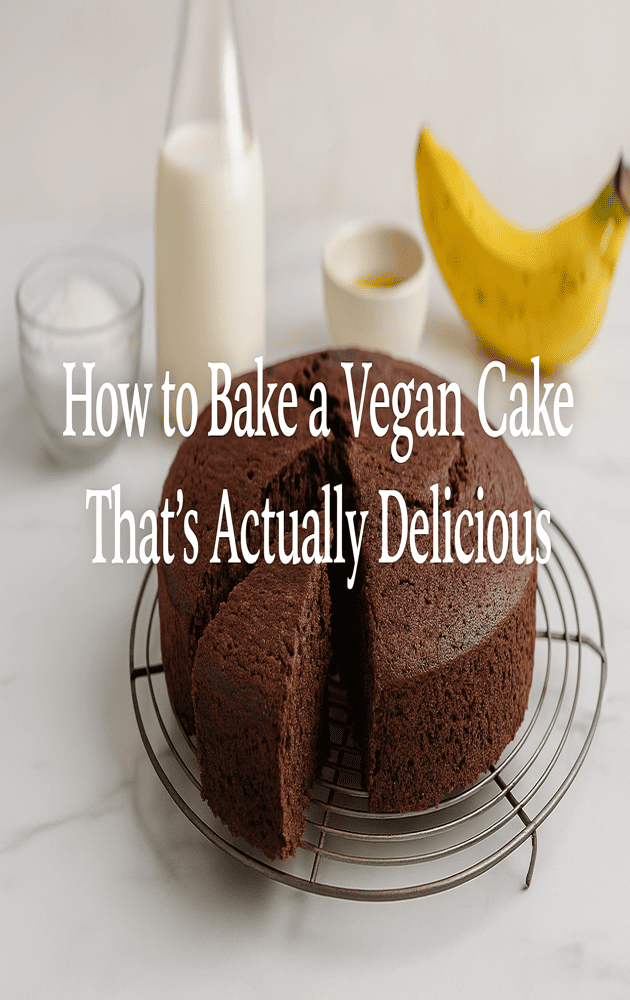Veganism is no longer just a trend—it’s a conscious lifestyle choice that reflects a growing concern for health, sustainability, and compassion. As more people move toward plant-based eating, desserts are also being reimagined. And that includes cake—yes, cake! It’s entirely possible to bake a moist, fluffy, rich vegan cake that delights every guest, no matter their dietary preferences.
In this article, we’ll walk you through how to create a vegan cake that’s not just “good for a vegan cake,” but genuinely satisfying and impressive. You’ll learn the science behind egg and dairy alternatives, how to maintain flavor and texture, and how to make your bakes memorable in every sense.
We’ll also connect to previous posts—like choosing the right flour (#7), mastering moisture (#15), healthy cake tips (#16), and making ingredient substitutions (#14 and #8)—to guide you through every step of the journey.
Why Vegan Cakes Matter More Than Ever
Health concerns, environmental awareness, food intolerances—these are just a few reasons people are moving toward plant-based diets. And desserts, once considered “guilty pleasures,” are now evolving into acts of self-care and intentional eating.
Vegan cakes offer:
- Reduced cholesterol and saturated fats
- No lactose (great for those with dairy intolerance)
- Lower inflammatory potential
- Nutrient-dense alternatives and wholesome ingredients
You’re not just baking a treat—you’re making something that’s kind to the body and the planet.
Eggs: The Classic Ingredient with Modern Alternatives
Eggs play a major role in traditional baking by providing:
- Structure
- Moisture
- Leavening (rise)
But that doesn’t mean they’re irreplaceable. Here are tried-and-tested vegan egg substitutes (1 egg = one of the following):
- Flax egg: 1 tbsp ground flaxseed + 3 tbsp water (let sit for 10 min)
- Chia egg: same as flax, with added crunch
- Mashed banana or applesauce: 1/4 cup per egg (adds sweetness and moisture)
- Plant-based yogurt: 1/4 cup per egg (for a soft, tender crumb)
- Vinegar + baking soda: 1 tbsp vinegar + 1/2 tsp baking soda (creates rise)
For chocolate or spice cakes, mashed banana is perfect. For lighter flavors, stick to flax eggs or yogurt.
Fats: Making the Right Plant-Based Choice
As we explored in article #8, fats affect everything from texture to richness. Luckily, vegan-friendly options are widely available:
- Refined coconut oil: neutral and melts beautifully
- Canola or sunflower oil: neutral taste and affordable
- Mashed avocado: great for darker cakes
- Nut butters: almond or cashew butter adds depth and creaminess
Fat is also key to keeping cakes moist and satisfying, especially when eggs are removed.
Plant-Based Milk: Variety That Works
Plant milks are more than a replacement—they offer unique properties that affect taste and structure.
Best options for baking:
- Almond milk: light, nutty, and versatile
- Soy milk: high in protein, best for structure
- Oat milk: slightly sweet and creamy
- Coconut milk: rich and indulgent, perfect for tropical bakes
Always use unsweetened versions to avoid oversweetening your batter.
Texture Tips: How to Achieve Soft, Fluffy, Vegan Cakes
Want a cake that’s tender and rises well? Here’s how:
- Use both baking powder and baking soda for optimal leavening
- Add an acid like apple cider vinegar or lemon juice
- Avoid overmixing the batter after adding flour—this keeps the crumb light
- Add cornstarch or potato starch (1–2 tbsp) to lighten the structure
- Follow the moisture tips from article #15 to avoid dryness
These small changes make a big impact.
Recipe: Vegan Chocolate Banana Cake (Tested & Loved)
Ingredients:
2 ripe bananas, mashed
1/2 cup brown or coconut sugar
1/3 cup refined coconut oil (or neutral vegetable oil)
1/2 cup unsweetened almond or oat milk
1 tbsp apple cider vinegar
1 cup whole wheat or all-purpose flour
1/3 cup cocoa powder
1 tsp baking powder
1/2 tsp baking soda
1 pinch salt
Optional: 1/4 cup vegan chocolate chips or chopped walnuts
Instructions:
- Preheat oven to 350°F (180°C). Grease a small loaf or round cake pan.
- Mix mashed bananas, sugar, oil, milk, and vinegar.
- In a separate bowl, whisk together dry ingredients.
- Combine the wet and dry gently, without overmixing.
- Fold in chocolate chips if using.
- Bake for 30–35 minutes. Let cool before slicing.
This cake is rich, tender, and deeply chocolatey—without a trace of dairy or eggs.
Add Flavor, Nutrition, and Joy
Vegan cakes are incredibly versatile. Try adding:
- Ground cinnamon, nutmeg, or ginger for warmth
- Grated orange zest or espresso powder to elevate chocolate
- Seeds, nuts, or dried fruits for texture
- A vegan ganache (dark chocolate + warm plant milk) or cashew cream frosting
As noted in article #16, healthy desserts are more satisfying when they include real ingredients that nourish and delight.
Common Mistakes to Avoid
- Don’t overbake: Vegan cakes dry out faster
- Let the cake cool before removing from the pan—vegan cakes can be delicate when hot
- Don’t skip the acid (vinegar or citrus) if you want a good rise
- Store properly: Airtight containers keep the cake soft and moist for longer
Final Thoughts: Cake That Nourishes and Connects
A vegan cake is more than a recipe—it’s a reflection of values. When you bake with intention, you offer more than a slice of sweetness. You offer care, compassion, and health in every bite.
Next up: “The Perfect Beginner’s Cake Decorating Kit”—because after nailing the recipe, it’s time to decorate and dazzle.
